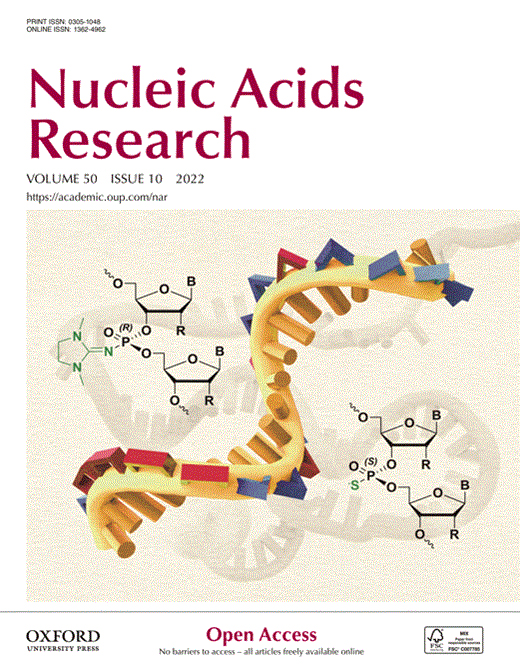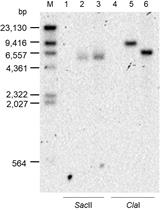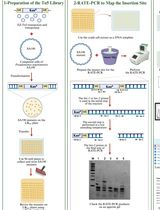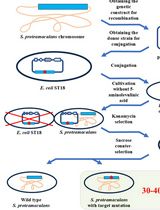- EN - English
- CN - 中文
A Novel Method of Inducible Directed Evolution to Evolve Complex Phenotypes
一种诱导定向进化,进化为复杂表型的新颖方法
(*contributed equally to this work) 发布: 2022年10月20日第12卷第20期 DOI: 10.21769/BioProtoc.4535 浏览次数: 2564
评审: Alessandro DidonnaVasudevan AchuthanChhuttan L MeenaRita Marie Celine Meganck
Abstract
Directed evolution is a powerful technique for identifying beneficial mutations in defined DNA sequences with the goal of improving desired phenotypes. Recent methodological advances have made the evolution of short DNA sequences quick and easy. However, the evolution of DNA sequences >5kb in length, notably gene clusters, is still a challenge for most existing methods. Since many important microbial phenotypes are encoded by multigene pathways, they are usually improved via adaptive laboratory evolution (ALE), which while straightforward to implement can suffer from off-target and hitchhiker mutations that can adversely affect the fitness of the evolved strain. We have therefore developed a new directed evolution method (Inducible Directed Evolution, IDE) that combines the specificity and throughput of recent continuous directed evolution methods with the ease of ALE. Here, we present detailed methods for operating Inducible Directed Evolution (IDE), which enables long (up to 85kb) DNA sequences to be mutated in a high throughput manner via a simple series of incubation steps. In IDE, an intracellular mutagenesis plasmid (MP) tunably mutagenizes the pathway of interest, located on the phagemid (PM). MP contains a mutagenic operon (danQ926, dam, seqA, emrR, ugi, and cda1) that can be expressed via the addition of a chemical inducer. Expression of the mutagenic operon during a cell cycle represses DNA repair mechanisms such as proofreading, translesion synthesis, mismatch repair, and base excision and selection, which leads to a higher mutation rate. Induction of the P1 lytic cycle results in packaging of the mutagenized phagemid, and the pathway-bearing phage particles infect naïve cells, generating a mutant library that can be screened or selected for improved variants. Successive rounds of IDE enable optimization of complex phenotypes encoded by large pathways (as of this writing up to 36 kb), without requiring inefficient transformation steps. Additionally, IDE avoids off-target genomic mutations and enables decoupling of mutagenesis and screening steps, establishing it as a powerful tool for optimizing complex phenotypes in E. coli.
Graphical abstract:

Figure 1. Overview of Inducible Directed Evolution (IDE). Pathways of interest are cloned into a P1 phagemid (PM) backbone and transformed into a strain ofE. coli containing MP (diversification strain). The mutagenesis plasmid is induced to generate mutations. Phage lysate is produced and used to infect a strain that expresses the phenotype of interest (screening/selection strain). The resulting strain library is screened to identify those with improved properties. Narrowed-down libraries can then go through another IDE cycle by infecting a fresh diversification strain.
Background
Complex phenotypes are defined as those that result from the combined action of multiple genes. Frequently, the genes that most limit these phenotypes are difficult to determine. Improvement of such phenotypes therefore requires methods that can diversify large pathways and screen or select for improved variants in a quick manner. Adaptive Laboratory Evolution (ALE) provides genome-wide diversification that is usually used to study the mechanisms and changes that can drive a microbial strain to adapt under a specific pressure. However, accumulation of genomic hitchhiker mutations complicates interpretation of ALE results. Directed evolution methods restrict mutations to a defined DNA sequence, avoiding hitchhikermutations, yet most methods are unable to evolve the large sequences of DNA necessary to optimize complex phenotypes, either due to poor transformation efficiency of large plasmids or low packaging limits for M13-phage–based methods, such as PACE (Esvelt et al., 2011). Here, we introduce Inducible Directed Evolution (IDE), a method for evolving large DNA pathways using the P1 phage. IDE combines key components of previous phage-based directed evolution methods, including an inducible mutagenesis plasmid, as well as a phage that transfers mutagenized DNA to unmutated cells, producing a screenable mutant library that is often larger than can be obtained using chemical or electrical transformation methods at similar effort. Instead of the M13 phage (which has a packaging limit <5 kb), IDE employs the P1 phage, whose large packaging limit (5–100 kb) enables much larger DNA sequences to be shuttled between cells. IDE avoids the troublesome hitchhiker mutations associated with ALE and CRISPR-based methods (Wang et al., 2009; Crook et al., 2019), decouples mutagenesis and screening steps, and allows large pathways to be evolved (up to 36 kb has been published thus far). IDE’s workflow is both fast and simple to adapt. First, the diversification strain is prepared by cloning the desired DNA sequence into the phagemid backbone (see section Construction of phagemid). Once the phagemid is constructed, it is transformed to the diversification strain (see section Construction of phagemid). The diversification strain containing the P1 phage, mutagenesis plasmid, and phagemid goes through mutagenesis (see section Induction of Mutagenesis). After the mutagenesis step is completed, diversified phagemids can be produced for screening/selection in an appropriate strain (see sections Phage production, Phage infection, and Screening/selection). This cycle is described in Figure 1 and can be repeated until improvement ceases, or the desired phenotypes are obtained.
Materials and Reagents
0.22 µm filter (Genesee Scientific, catalog number: 25-227 or equivalent), store at room temperature
PCR tubes (Thermo Fisher Scientific, Eppendorf, catalog number: E0030124286 or equivalent), store at room temperature
14 mL culture tubes (Thermo Fisher Scientific, Falcon, catalog number: 14-959-1B or equivalent), store at room temperature
50 mL tubes (Thermo Fisher Scientific, Genesee Scientific Corporation, catalog number: NC1259986 or equivalent), store at room temperature
50 mL reactor tubes (Greiner Bio-One CELLSTAR® CELLreactor Conical Bottom Polypropylene Filter Top Tube 227245 or equivalent)
1.7 mL microtubes (Thermo Fisher Scientific, Genesee Scientific Corporation, catalog number: NC2045332 or equivalent), store at room temperature
Serological pipets (Thermo Fisher Scientific, Genesee Scientific Corporation, catalog number: NC0631030 or equivalent), store at room temperature
Shake flask (Thermo Fisher Scientific, PYREX, catalog number: 09-552-32 or equivalent), store at room temperature
Petri dishes (Genesee Scientific, catalog number: 32-107G or equivalent), store at room temperature
96-deep-well plates (VWR International, catalog number: 10755-248 or equivalent), store at room temperature
Pipette tips (Genesee Scientific, catalog number: 23-130RL & 24-150R & 24-160RS or equivalent), store at room temperature
Electroporation cuvette 1 mm (Genesee Scientific, catalog number: 40-100), store at room temperature
Nuclease-free water (Thermo Fisher Scientific, catalog number: J71786.K2 or equivalent), store at room temperature
Virkon (VirkonTM S Broad Spectrum Disinfectant, Chemours), store at room temperature
L-Arabinose (Teknova, catalog number: A2010 or equivalent), store at room temperature
Chloroform (Thermo Fisher Scientific, catalog number: J67241.AP or equivalent), store at room temperature
Anhydrotetracycline hydrochloride (Thermo Fisher Scientific, catalog number: J66688.MB or equivalent), store at -20 °C
Dextrose (D-Glucose) (Thermo Fisher Scientific, catalog number: D16-1 or equivalent), store at room temperature
OneTaq 2× Master Mix with Standard Buffer (New England Biolabs, catalog number: M0482S or equivalent), store at -20 °C
Q5 Site-Directed Mutagenesis Kit (New England Biolabs, catalog number: E0554S or equivalent), store at -20 °C
Q5 Hot Start High-Fidelity 2× Master Mix (New England Biolabs, catalog number: M0494S or equivalent), store at -20 °C
SGI-DNA Gibson Assembly® (GA) HiFi 1-Step Kit (CODEX DNA, Inc., catalog number: GA1200), store at -20 °C
NEBuilder® HiFi DNA Assembly Master Mix (New England Biolabs, catalog number: E2621S), store at -20 °C
NEB® 5-alpha Competent E. coli (New England Biolabs, catalog number: C2987H or equivalent). Store at -80 °C.
NEB® 10-beta Competent E. coli (New England Biolabs, catalog number: C3019H or equivalent). Store at -80 °C.
LB broth (Thermo Fisher Scientific, BD Difco, catalog number: DF0446-07-5 or equivalent), store at room temperature
Ampicillin sodium salt (Sigma-Aldrich, catalog number: A0166-25G or equivalent), store at room temperature
Chloramphenicol (VWR, catalog number: 97061-244or equivalent), store at room temperature
Kanamycin monosulfate (TCI America, catalog number: K0047 or equivalent), store at room temperature
Magnesium chloride hexahydrate (VWR, catalog number: BDH9244-500G or equivalent), store at room temperature
Calcium chloride dihydrate (Thermo Fisher Scientific, catalog number: C79-500 or equivalent), store at room temperature
TAE buffer (Tris-Acetate-EDTA) 50× (Thermo Fisher Scientific, catalog number: BP133220 or equivalent), store at room temperature
Gel loading dye (New England Biolabs, catalog number: B7024S or equivalent), store at room temperature
SYBRTM Safe DNA Gel Stain (Thermo Fisher Scientific, Invitrogen, catalog number: S33102 or equivalent), store at room temperature
Quick-Load® 1 kb Plus DNA Ladder (New England Biolabs, catalog number: N0469S or equivalent), store at room temperature
DpnI (New England Biolabs, catalog number: R0176S or equivalent), store at -20 °C
Agarose (Thermo Fisher Scientific, Lonza Inc, catalog number: BMA50004 or equivalent), store at room temperature
Plasmid Miniprep Kit (Zyppy Plasmid Miniprep Kit, Zymo Research, catalog number: D4019 or equivalent), store at room temperature
DNA Library Prep Master Mix (New England Biolabs, catalog number: E6040S or equivalent), store at -20 °C
QIAamp DNA Kit (Qiagen, catalog number: 56304), store at room temperature
DNA Clean and Concentrator-5 kit (Zymo Research, catalog number: D4004 or equivalent), store at room temperature
1× DPBS (Thermo Fisher Scientific, Gibco, catalog number: 14-190-136 or equivalent), store at room temperature
Glycerol (Thermo Fisher Scientific, catalog number: G33-4 or equivalent), store at room temperature
Sodium citrate tribasic dihydrate (Sigma-Aldrich, catalog number: C7254-1KG or equivalent), store at room temperature
Super Optimal Broth (Thermo Fisher Scientific, Bioworld, catalog number: 50-254-370 or equivalent), store at room temperature
Phagemid backbone (Addgene, catalog number: 40782)
MP6 plasmid (Addgene, catalog number: 69669)
aTc inducible promoter (Addgene, catalog number: 108529)
aTc-MP6 plasmid (Addgene, catalog number: 189935)
Primer #1: Forward primer for amplifying phagemid backbone: aggatccgaggcttggattc
Primer #2: Reverse primer for amplifying phagemid backbone: atgagatctctatgctactc
Primer #3: Mutagenic operon Forward primer: acccgtttttttggacgcgt
Primer #4: Mutagenic operon Reverse primer: agtcaaaagcctccgaccgg
Primer #5: CloDF13 Forward primer: tacgtgccaagccaaatagg
Primer #6: CloDF13 Reverse primer: ggctgacttcaggtgctaca
Primer #7: pTet and KanR Forward primer: cagtggaacgaaaaatcaat
Primer #8: pTet and KanR Reverse primer: tcagtatctctatcactgat
Primer #9: TetR Forward primer: ctcggtaccaaattccagaa
Primer #10: TetR Reverse primer: ctcacttccctgttaagtat
Note: Primers/Oligos can be ordered from Eurofins Genomics or equivalent supplier.
Ampicillin sodium salt (100 mg/mL) (see Recipes)
Chloramphenicol (34 mg/mL) (see Recipes)
Kanamycin monosulfate (50 mg/mL) (see Recipes)
10% glycerol (see Recipes)
LB media (see Recipes)
PLM (see Recipes), store at room temperature
ePLM (see Recipes), store at room temperature
Super Optimal Broth with glucose (SOC) containing 200 mM sodium citrate (see Recipes)
Equipment
iSeq 100 or equivalent (Illumina, catalog number: 20021532)
-80 °C freezer (Thermo Fisher Scientific, Revco RLE Series, model number: RLE50086A)
-20 °C freezer (Thermo Fisher Scientific, Isotemp, model number: 20LFEEFSA)
4 °C refrigerator (Jordon Refrigeration)
Microplate reader (Agilent BioTek, Synergy H1, catalog number: 11-120-535)
I26 shaking incubator (New Brunswick Scientific, Eppendorf, part number: M1324-000)
Convection incubator (VWR, Symphony, part number: 414004-610)
Incubating microplate shaker (Thermo Fisher Scientific, catalog number: 02-217-759)
Centrifuge (Thermo Fisher Scientific, Sorvall Legend X1R, catalog number: 75004261)
Microcentrifuge (Thermo Fisher Scientific, Sorvall Legend Micro 21R, catalog number: 75-002-446)
Mini Centrifuge (Thermo Fisher Scientific, catalog number: 05-090-100)
Thermocycler (Eppendorf, Mastercycler nexus eco, catalog number: 6330000021)
Gradient Thermocycler (Eppendorf, Mastercycler nexus gradient, catalog number: 6331000025)
Single channel adjustable pipettors, 0.01–1,000 µL (Eppendorf)
Multichannel adjustable pipettors 1–1,000 µL (Eppendorf)
Flow cytometer (BD Biosciences, AccuriTM C6 Plus, catalog number: 660517)
Digital dry bath heat block (Benchmark Scientific, model number: BSH1001)
MicroPulser Electroporator (Bio-Rad, catalog number: 1652100)
Spectrophotometer (Thermo Fisher Scientific, NanoDropTM 2000c, catalog number: ND-2000C)
DNA Electrophoresis Cell (Bio-Rad, Mini-Sub Cell GT Tray, catalog number: 1664400EDU)
DNA Electrophoresis Power Supply (Bio-Rad, PowerPacTM Basic, catalog number: 1645050)
Gel Imager (Bio-Rad, Gel DocTM EZ Imager, catalog number: 170-8270)
Software
Samtools (BSD, MIT, http://www.htslib.org/)
BCFtools (BSD, MIT, http://www.htslib.org/)
VarScan ( http://varscan.sourceforge.net/)
Benchling ( https://www.benchling.com) or equivalent plasmid management software
Procedure
文章信息
版权信息
© 2022 The Authors; exclusive licensee Bio-protocol LLC.
如何引用
Al'Abri, I. S., Li, Z., Haller, D. J. and Crook, N. (2022). A Novel Method of Inducible Directed Evolution to Evolve Complex Phenotypes. Bio-protocol 12(20): e4535. DOI: 10.21769/BioProtoc.4535.
分类
生物工程 > 合成生物学
分子生物学 > DNA > 诱/突变
分子生物学 > DNA > 转染
您对这篇实验方法有问题吗?
在此处发布您的问题,我们将邀请本文作者来回答。同时,我们会将您的问题发布到Bio-protocol Exchange,以便寻求社区成员的帮助。
提问指南
+ 问题描述
写下详细的问题描述,包括所有有助于他人回答您问题的信息(例如实验过程、条件和相关图像等)。
Share
Bluesky
X
Copy link












